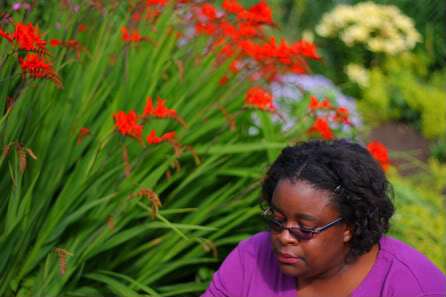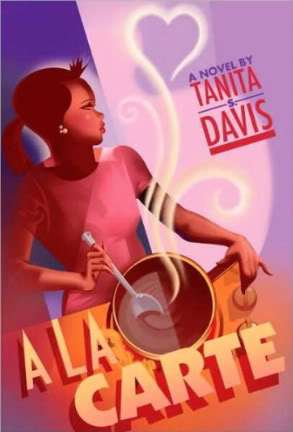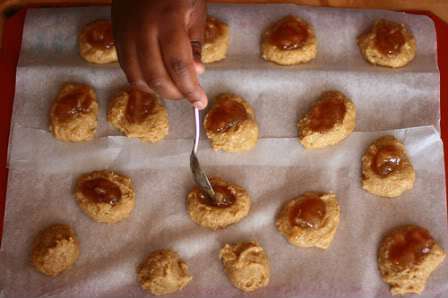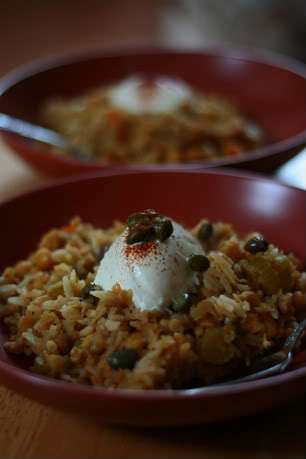
Recipe for a Delicious Young Adult Novel:
Take one smart-as-a-whip, talented, vegetarian, Thai-food-loving, gregariously introverted, voracious reader and lifelong writer named Tanita S. Davis,
Give her a laptop, quiet time, patience, perseverance, and a husband, David, who just happens to be the world’s best baker,
Allow her imagination to concoct a coming-of-age story about a 17-year-old girl named Lainey, who dreams of having her own vegetarian cooking show;
Add Lainey’s ex-best friend and secret crush, Simeon, who stirs things up by hanging with new friends, taking her for granted, and suddenly leaving home,
Then let everything simmer and stew in scenes that are fresh, biting, sweet, a little spicy, and explosive, every chapter enhanced with handwritten recipes —
And you have, One. Feast. Of. A. Good. Book.

A La Carte, Tanita’s first novel, was just released in June, and I would call it a favorite even if I wasn’t already shamelessly partial to food-related books. The kitchen scenes are engaging, sensual, convincing, and emotionally resonant, and the story of how Lainey comes into her own, despite being treated so poorly by the guy she loves, will stay with me for a long time.
Originally from California, Tanita is visiting today from Glasgow, Scotland, where she lives with David in a converted church called the Angel Building. How cool is that?! Some of you may know that she’s also an avid blogger, reviewer, and champion of YA books, who goes by the name of TadMack. And this girl can cook! I know you’ll enjoy what she’s serving up today:
Welcome to alphabet soup, Tanita, and congratulations on the publication of A La Carte! Please tell us what inspired the story and about some of the challenges you faced creating it.
Thanks! A few years ago I read a YA retelling of the Cyrano story, with some great recipes in it. However, all of the recipes were for things like ‘Death by Chocolate’ and that type of thing. I was a pudgy kid who grew into a pudgy adult, and though I loved the book, I wanted to write a story where someone incorporated healthier recipes. That was the germ of the idea that started the book.
Keeping Lainey true to herself was the most challenging thing about this novel. A lot of us grew up with the fairytale ideal, and sometimes in writing there is an immense desire to have a “happily ever after” that includes a boyfriend or girlfriend. The fact is, a lot of times, that doesn’t happen. A lot of times, Lainey needed a happily-ever-after just for herself . . . someday there might be a boy, sure, but for now, I think she’s thrilled with what she’s got, who she is, and the potential “somedays” before her.

Like you, Lainey is a vegetarian and an innovative cook. Did you draw heavily from personal experience when creating her character?
Lainey is pulled together from a compilation of myself and several friends, male and female, who are always the “friend” and never the romantic interest. It’s hard for people to lay a boundary around . . . well, their own desires, when things like that happen. People I observed in high school and college had friends they loved, and they gave and gave and gave to them.
Some of the objects of their affection weren’t worthy of that affection, and they ended up being really walked on, and not knowing how to respond. It’s really important for anybody, guy or girl, to learn to value themselves enough to require a return on the gift of friendship. If your friends aren’t reciprocating, it might be time to disengage and find new friends. Easy thing to say, hard thing to learn, I know!
Both Sim and Topher are so convincingly depicted. Do you find it harder to write male characters?
Thanks for complimenting Sim and Topher! A lot of times, female writers are taught to believe that it’s harder for them to write convincing male characters, but I believe that a writer has to focus on who the character is to ‘hear’ their voices and portray them as they are. I had a conversation about this just recently with another writer, and I had to sort of take back some of my preconceptions.
I think we are taught to assume, “Oh, well, guys, when you write them, you have to use terse sentence structure, and keep things really tight and minimal,” but I don’t think all guys sound a particular way, and it’s crucial to keep assumptions and stereotyping out of writing. At least, that’s important to me.


Tell us a little about your evolution and apprenticeship as a writer (early influences, favorite authors, why you chose YA). What were you like as a child?
My experience with fiction was limited as a young adult — my parents tried hard to ground their dreamy child by requiring me to read non-fiction only. In the third grade I found a battered copy of Anne of Green Gables that the school library was throwing away. It was a 1950’s edition, bound in green with a brown spine. I loved that book, and it began in me a love of words. I started talking like Anne, at the age of nine. I must have been such a weird kid — I told people about ‘epochs’ in my life, and ‘kindred spirits’ was one of my favorite phrases. I don’t think I ever grew out of the wonder of finding Anne, finding someone years out of my time, but really, just as weird as me. I want to give that experience to someone else.
The question of what draws me to YA writing in particular is a difficult one to answer. Maybe it’s just a matter of not being drawn to adult novels? I don’t know — YA novels interest me because the YA world is still open to possibility, unique solutions, different ways of seeing, and new stories. As a genre, it’s the most tightly edited, creatively presented and freshest thing going outside of maybe Science Fiction and Fantasy, and that’s embraced into YA. I’m just not as interested in adult themes, I guess; adult writing tries to figure out things I haven’t had time to get interested in yet. A lot of times it seems more detached and that’s not where my interests lie. That probably doesn’t make sense, but it’s all I’ve got.

How do you approach a new project — lots of prewriting? character sketches? outlines? scenes in or out of order? What part of writing do you like the most? the least?
I can’t seem to make it through a week without thinking of something new! I have a very active imagination — and I have stories lined up in my brain, all trying to push to the forefront. There are three notebooks on my desk strictly for when I have a thought, and still I end up jotting things down on the backs of envelopes and sticky notes. I don’t have an organized mind.
One of my MFA instructors advocated outlines, and we were required to write them — that was really difficult for me. I hate outlining in a traditional way, but I’m pretty good with . . . kind of a Venn-diagrammy looking thing, that has lots of arrows. When I get stuck working out how to get a character from where they are, to the sort of Big Picture I need to move them toward, then I start jotting down phrases and ideas and connecting them with arrows . . . Again, it’s not very neat, but it works.
Even when I first started writing, I knew better than to try to pass off my stories at only one draft — but I tend to rewrite while I’m writing the first draft — that’s just how my circuitous brain works. I take two steps forward, and then go back a chapter and rewrite several paragraphs, and then that gives me impetus to move forward another two steps . . . and then back one. My long-suffering writing partners got used to reading multiple copies of the same story, and by the time I’m finished with anything, I honestly feel like I know it by heart.
But rewriting for other people was tough, seriously tough. My first novel took six drafts to get it where my agent liked it, and then at least another six before my editor thought it was done. And that’s not to mention the two rounds I did with copy editing! I realized I needed to learn to love the process — what I do love is the feeling of exhilaration at the teamwork that takes place, and the feeling of accomplishment that what I’ve written is understood and appreciated.

What are you working on now?
I just finished MARE’S WAR, which is scheduled to be published June of ’09. At the moment, I’m trying to finish my work in progress by the end of the month; until I’m actually finished with it, it’s hard to explain! Suffice it to say that it’s a family story about a brother and sister whose concept of ‘family’ has to change and grow in order for them to be happy where they are.
I heard John Green at SCBWI’s L.A. Conference in 2007. He said “All writing is rewriting,” and while it’s not exactly advice, it’s a truism that means that you always have to be prepared to roll up your map and strike out cross-country in terms of your manuscript. What you have — where you’ve already been — may not be where you need to go!
The best piece of writing advice I can pass on is to get a writing group, and don’t be too stubborn to rewrite. I think the biggest mistake we can make is to be so convinced of our own genius that we want our work to stay exactly as we have envisioned it, despite comments that indicate that it’s not being understood the way we’d like. Writing is a collaborative effort, and if your writing group and your editor is nudging you into some new directions, never be afraid to at least consider them. It may sound clichéd, but letting go of our personal pride sometimes means being able to have our hands and minds open enough to have room for inspiration.
For me, cooking and writing are both arts, thus they are created with the rule that there are few mistakes in either. This isn’t to say no mistakes, because sometimes when something’s burned, it’s over — and there are some stories that, well, you just have to rewrite! But rarely are there mistakes that from which one cannot recover. There are merely new ways of seeing things; rewriting or re-seasoning something makes a whole new dish.
I’m envious of you living in Scotland, and know you love cooking from scratch. What are some of the new or different culinary adventures you’ve had since moving there? Any big adjustments in the kitchen?

Everyone asks if we’ve tried haggis, the traditional Scottish sausage type of thing which is a sheep’s stomach stuffed with oats and entrails and cooked with the esophagus hanging out of the pot. Short answer: Me = vegetarian. Longer answer, nope, but if you’re a sausage person, it probably won’t bother you. There’s a vegetarian version that is reasonably tasty, and on Burn’s Night, we indulged in that with “neeps and tatties,” which are turnips and potatoes.

QUICK BITES
Describe yourself in 5 words.
Argh! These are always so hard! Creative, Conflicted, Decisive, Thoughtful, Amused (Easily)
Passions besides reading and writing.
Music, Art, Eating, Swimming
Three fondest wishes.
The art to reach and touch those who need it,
the heart to do the most with what I have,
and the head to realize what I’ve got right now.
Hidden talents.
Gee, I wish I could put something like yodeling or something. But I’m good with Sculpey (modeling clay), and I do a mean color-in-the-lines. I play well with others. Mostly.
Secret crush.
It’s not much of a secret, but I think Richard Peck is gorgeous, as is Holly Black.
If you could invite anyone, living or dead, real or imaginary, to dinner, who would it be, and what would you cook for him/her?
Wouldn’t it be a kick to have St. Julia to dinner? She could bring Jacques Pepin, of course. And they would pick the wine, because I know nothing from wine.

Oh, and dessert? Something light, perhaps just fruit and chocolate. Marinated cherries with peppercorn ice cream. Mango sorbets and raspberry coulis . . . the list could go on and on!

Please share a recipe and tell us a little about it.
I absolutely adore Thai food. I have an ongoing list of The Best Thai Places Ever, and I continue to add onto it as I visit various cities and countries. (When I go to Thailand someday, I’m pretty sure then it will be time to retire the list!)
The recipe in Chapter 13, Pia’s Cabbage Slaw, came from an appetizer salad I used to have at a favorite restaurant in the Sonoma Valley. It was so easy — thinly slivered cabbage and carrots, garnished with chopped peanuts and a sweet-spicy red pepper sauce. Being me, I added to it. Sometimes I make it with cabbage and carrots, mostly recently I’ve used kohlrabi. It’s fresh and fast and very good for the root-veg intensive UK diet!
PIA’S CABBAGE SLAW
2 cups cabbage (use both red and green for extra color)
1 green onion (chiffonaded — chives snipped into bits works too)
2 T (or more) ginger-habanero salad dressing
1 tsp (or more) Mae Ploy sweet pepper sauce
1/4 cup fried chow mein noodles
1/4 cup honey-roasted soy nuts
Scattered handful of raisins or dried cranberries or dried pineapple
Using a box grater or a mandoline grater, shred cabbage finely. Add to bowl containing finely sliced onions.
Dress cabbage and onion with ginger-habanero dressing. Add Mae Ploy sauce to taste. Garnish with crunchy noodles and soy nuts. Add optional fruit.
**Watch out for the pepper sauce: this can get too spicy fast. Add another cup of chopped cabbage if that happens, or 1 cup fresh medium tofu chunks, lightly stir-fried, or mushrooms.

Tanita blogs as TadMack at Finding Wonderland, Readers’ Rants, and Wish I Were Baking.
Her 2007 Interview at Seven Impossible Things Before Breakfast is here.
See Tanita chatting with Alkelda of Saints and Spinners here.
Check out these reviews of A La Carte by:
Little Willow ( )
Thanks for visiting, Tanita!

TadMack says: 🙂
And thank you for inviting me!
(Why am I suddenly starving!?)
LikeLike
WOWSERS! I admit to something: I put out watercolor paper and paints for my girls so that I could sit down and read this slooooowly and with no interruption. What a fabulous interview, and what a gorgeous opening photo! And to this, TadMack, I say amen: “It’s crucial to keep assumptions and stereotyping out of writing.”
I can’t wait to start my copy of A La Carte. I keep waiting ’til I’m not reading anything else so that I can savor it (pun intended), but I guess that will never happen, as I’m always reading 5 books at once.
That library across the street looks awesome in about seven different directions.
Thanks for this wonderful interview!
Jules, 7-Imp
LikeLike
Oh, no. I have to take my kids to lunch. Then I’ll be back to read all of this. Woo-hoo! I’m excited to see what you asked and what the Great TacMack answered.
My eye caught “list of best Thai places ever” Oh, Tanita, I may have to buy that off you. I adore Thai food, and even though it might make you jealous to say this, I first ate it…in Thailand. What a gorgeous country, filled with the most beautiful people. One of my favorite trips ever.
Okay, I’ll be back…
LikeLike
Re: TadMack says: 🙂
You aren’t the only one. Off to make some slaw . . .
LikeLike
Thanks for reading, Jules. I loved all her answers, especially the ones about craft, and of course, her dinner with Julia and Jacques :).
LikeLike
I’m so glad you featured, this, Jama! I just finished this book and adored it! Even though I am totally not a cook (nor a gourmet of any kind), I loved the food setting of this whole novel. And the characters were so wonderful. Most of all, though, the ending wowed me. The realism of it, yet the hopefulness, and Lainey’s growth…beautifully done!
Yea, Tanita!
LikeLike
So glad you share my enthusiasm for A La Carte, Laura! The food setting was indeed scrumptious; it was a great backdrop but I loved the way it defined the character. It’s wonderful to have a “foodie” book for YA readers, since adults have Like Water for Chocolate, and MG readers have Everything on a Waffle.
LikeLike
I really enjoyed reading this. Thanks for such a thoughtful interview, and for a chance to get to “know” TadMack a little better!
The section on revision is fascinating. There’s such an attachment to that first set of words, such a reluctance to let go of them and rethink. But the effort really pays off.
Sounds like a great book, though it’ll make me hungry!
LikeLike
From a. fortis
Yay for kindred spirits! And yum on the kohlrabi slaw – I’ll have to try that. Great interview!
LikeLike
It’ll definitely make you hungry, Janet, but it’ll also inspire you to want to try the recipes. They’re so varied and in perfect tune with the chapters. I agree that her remarks about revising were fascinating. I’m in awe of the commitment and tenacity required of novelists. All writing is difficult, but to me, the novel feels large and unwieldy. I’m so used to the short form.
LikeLike
Re: From a. fortis
After I first read the Anne books, I also went around looking for kindred spirits. Through the years, I’ve discovered you don’t necessarily have to seek them out, you’ll just KNOW, right away, when you run into them.
LikeLike
Go, Tanita!
What a great interview, Jama and Tanita! I loved reading it 🙂
And, I want the rhubarb cookies!!
LikeLike
TadMack and Jama — thanks for sharing all the photos! Nothing brings a person more to life than pictures of where she shops, what’s across the street from her — can I even call that a house??? WOW! — and her desk. Very fun.
LikeLike
Re: Go, Tanita!
Glad you enjoyed it, Kelly. Me want some cookies, too :)!
LikeLike
Her “apartment building” is really amazing, isn’t it? What a great experience living in Scotland!
LikeLike
Tanita!
I absolutely adore TadMack/Tanita, and this interview captures all the things I love about her: enthusiasm for literature, sense of humor, ability to turn an original phrase, and down-to-earthiness. Also, omigod the FOOD! These pics are amazing! Thanks, Jama and TadMack!
~eisha (7-Imp)
LikeLike
Re: Tanita!
Glad you stopped by to read, Eisha! Don’t you think TadMack should invite US to dinner?
LikeLike
Hurrah for Tanita! Hurrah for healthy foodstuffs! Amen for realistic endings (and beginnings, and middles) and for realistic characters, regardless of gender.
I love the inclusion and design of the recipes in the book.
Another tasty interview, Jama. 🙂
Ah, yes, Flavor of the Week – another yummy book! I have yet to make Kitchen Sink Cookies, but I did try out those delicious sugary sandwiches.
LikeLike
Thanks, LW. Is there any book you don’t know about? Now I have to read Flavor of the Week! Sounds yummy :).
LikeLike
It is delicious and cute. For more Cyrano, there’s the forthcoming At Face Value by Emily Franklin, but it is sans recipes/cooking. Instead, it flips the genders – Rox is the guy, a nickname derived from his last name, and the protag is a girl named Cyrie Bergerac.
LikeLike
That sounds good too. Love the name Cyrie.
BTW, loved your SCBWI Readergirlz interview videos. Of course I was stunned at how young you are. How can so much brilliance belong to just one person?
LikeLike
I enjoy Emily’s writing. I think Liner Notes is my favorite novel of hers to date.
Thanks for watching the videos, and thanks for the kind words! I’m much older than I look!
LikeLike
Lovely!
I enjoyed reading this interview so much, Jama and Tanita. I waited until I’d finished “A La Carte” last night to read it. I just LOVED “A La Carte.” Just loved that book! Thanks to both of you for the lovely chat here. That was the dessert after the novel!
Susan T.
Chicken Spaghetti
LikeLike
Wonderful interview. I loved A la Carte and really enjoyed reading more about Tanita. Tad, I was another kid walking around talking about “kindred spirts” and “scrapes” (not to mention being the friend instead of the romantic interest) later on.
I loved ogling your gorgeous recipes here and agree that female writers are taught to believe that it’s harder for them to write convincing male characters but that the whole thing about males and terse sentence structure is a ridiculously simplistic generalization.
I can’t wait to read Mare’s War next summer! And thank God I ate lunch before looking at this page otherwise I’d be wiping drool off my keyboard!
LikeLike
Re: Lovely!
Thanks for stopping by to read, Susan. I totally agree with you on the deliciousness of this novel. I hope Tanita writes more food books — or even a sequel to this one, showing how Lainey gets her own show and everything.
LikeLike
Thanks for reading and being a kindred spirit!
LikeLike
What a great interview! My mouth is watering from all the photos and talk of food. Can’t wait to read the book!
LikeLike
I’m sure you’ll enjoy the book, and will want to try some of the recipes. Tanita has me convinced to go get some Mae Ploy Sweet Chili Sauce and Habanero dressing!
LikeLike
I’m back, and now I’ve read the book, too! Tanita writes with such love and precision about food that it makes me look at every bite I’ve eaten since with new eyes. And the beets! And the gingerbread!
Why did I call you TacMack in that comment above? TadMack, Tanita dear, so sorry. Shall I just call you Saint Foodie? 🙂
LikeLike
That was me, both times. Why does LJ keeping logging me out?
LikeLike
Sorry, don’t know why you’re having this log-out problem.
You’ve been to Thailand? Wow. I agree with your assessment of Tanita writing about food with love and precision. Yes, I was tempted to lick the pages. Most of all, I love Tanita and Lainey’s innovative, experimental approach to cooking. It sure beats the same old same old monotony of “what shall I cook for dinner?”
LikeLike